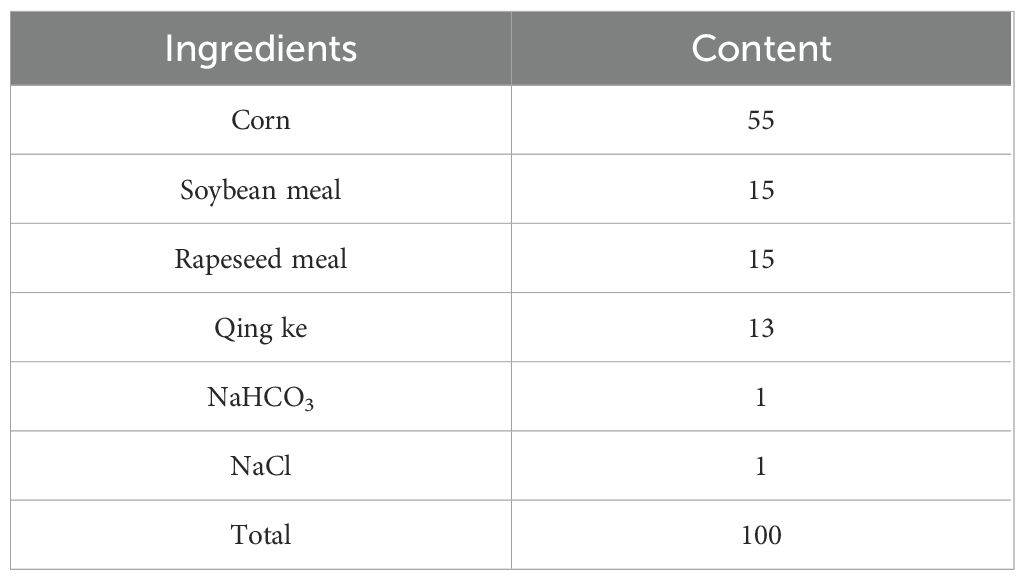- 1College of Veterinary Medicine, Gansu Agricultural University, Lanzhou, China
- 2College of Food Science and Engineering, Gansu Agricultural University, Lanzhou, China
- 3Qinghai Haibei Animal Husbandry and Veterinary Science Research Institute, Haibei, China
Background: Intensive yak farming enhances reproductive rates. However, it leads to dietary and sunlight deficiencies, which adversely affect growth and immunity in yaks. This 90-day randomized controlled trial (n=32) systematically evaluated the effects of Wuwei Jianpi San (WJPS), a traditional Chinese herbal formulation, on growth performance, immune function, gut microbiota, and bile acid metabolism in yaks, which is the first systematic association between the traditional Chinese medicine compound WJPS and the multi omics characteristics of yak intestines, aiming to address these challenges.
Results: WJPS supplementation elicited profound phenotypic improvements, including increased in average daily gain (ADG) and a reduction in feed conversion ratio (FCR)(P<0.05), alongside systemic immunomodulation manifested as elevation in lymphocyte count, upregulation of serum IgG(P<0.05), and enhancement of glutathione peroxidase (GSH-Px) activity (P<0.05), without compromising intestinal morphological integrity. Multi-omics analyses unveiled a tripartite mechanism driving these effects. Gut Microbiome Remodeling: WJPS fostered a beneficial microbial ecosystem, significantly enriching commensal taxa such as Ruminococcus and Bacteroides, while suppressing pathogenic Staphylococcus and Streptococcus. Bile Acid Metabolism Reprogramming: WJPS induced a shift in intestinal bile acid profiles, characterized by a decrease in pro-inflammatory taurocholic acid and increased in lithocholic acid—a key agonist of the farnesoid X receptor (FXR)(P<0.05). Concomitantly, colon tissues exhibited upregulation of FXR signaling and suppression of CYP7A1(P<0.05), linking microbiome-derived bile acid metabolites to metabolic regulation. Inflammation Resolution: the formulation attenuated pro-inflammatory cascades, evidenced by a reduction in IL-17A and downregulation of IL-1β(P<0.01), while preserving anti-inflammatory IL-10 homeostasis.
Conclusions: These findings establish WJPS as a multi-target phytogenic modulator that the relative abundance of beneficial bacteria such as Ruminococcus and modulates the relative levels of compounds like glycochenodeoxycholic acid and taurodeoxycholic acid, thereby improving gut health, bile acid signaling, and immunometabolic regulation to enhance ruminant health and productivity. These results provide a translational framework for developing herbal-based feed additives in sustainable livestock production, offering a promising alternative to antimicrobial growth promoters.
1 Introduction
Yaks (Bos grunniens), indigenous to the high-altitude regions of the Tibetan Plateau and adjacent areas (Tibet, Qinghai, and Gansu provinces), represent a crucial livestock resource for local ecosystems (Yang et al., 2024). The modernization of yak husbandry has witnessed a shift from traditional pastoral systems to intensive housing, aimed at improving reproductive efficiency and management. However, this transition has introduced nutritional challenges, including dietary monotony and reduced sunlight exposure, which compromise growth performance and immune competence. Conventional interventions, particularly antibiotics, are increasingly ineffective due to rising antimicrobial resistance and pose risks of drug residues, while probiotic applications are often limited by poor adaptability to the unique yak gut environment and variable efficacy under harsh conditions.
Wuwei Jianpi San (WJPS), a compound Chinese herbal formulation comprising Codonopsis pilosula, Astragalus membranaceus, Crataegus pinnatifida, Citrus reticulata pericarpium, and Massa Medicata Fermentata, offers a phytogenic solution to these constraints. Rich in bioactive compounds (polysaccharides, flavonoids, and saponins), these compounds enhances digestive function and nutrient assimilation (Wang, 2016). Emerging evidence underscores the gut microbiota as a pivotal interface between nutrition and host physiology, influencing metabolism, immunity, and disease resistance (Li et al., 2021). Notably, herbal medicines can function as prebiotics, modulating microbial ecology to promote intestinal homeostasis (Zhou et al., 2024). The advent of metagenomic sequencing has revolutionized microbiome research, enabling high-resolution taxonomic and functional profiling of microbial communities. Concurrently, bile acids—microbial-derived metabolites of cholesterol—have emerged as key regulators of host-microbe crosstalk (Zang et al., 2025). These amphipathic molecules mediate nutrient absorption and lipid metabolism while maintaining hepatic-intestinal axis homeostasis (Shen et al., 2024). The bidirectional interaction between bile acids and gut microbiota is particularly consequential: bile acids shape microbial composition, while microbiota transform primary bile acids into secondary forms via deconjugation, dehydroxylation, and other biotransformations (Lei et al., 2020). Central to this interplay is the farnesoid X receptor (FXR), a nuclear receptor abundantly expressed in the intestine. Activated by bile acids, FXR orchestrates feedback regulation of bile acid synthesis (via CYP7A1 suppression) and modulates intestinal ecology (Chandra Shekhara et al., 2020).
Based on this mechanistic framework, we hypothesized that WJPS supplementation would enhance yak productivity through three synergistic pathways: (1) direct nutritional optimization by improving digestive efficiency and nutrient bioavailability; (2) ecological remodeling of gut microbiota through selective enrichment of beneficial taxa and suppression of pathogens; and (3) metabolic regulation via the bile acid-FXR signaling axis. To rigorously evaluate this hypothesis, we implemented a tiered analytical approach that systematically assessed treatment effects across multiple biological scales: first quantifying whole-animal growth performance (ADG), then examining systemic responses through serum immunological and redox profiling, followed by deep characterization of gut microbial ecology using metagenomic sequencing, targeted bile acid metabolomics to map metabolic transformations, and finally molecular analysis of FXR pathway activity in intestinal tissues. This comprehensive experimental design enabled us to establish causal links between WJPS intervention, microbial community shifts, metabolic reprogramming, and ultimately improved host physiology, providing a mechanistic foundation for WJPS application in ruminant nutrition. This integrated approach enabled systematic investigation of WJPS action across multiple biological levels, from whole-organism performance to molecular pathways. This investigation provides both mechanistic insights into WJPS action and practical evidence for its application in sustainable yak production systems. We hypothesize that WJPS regulates the gut microbiota structure, particularly by increasing the abundance of short chain fatty acid producing bacteria, which in turn affects the host bile acid metabolism spectrum, ultimately synergistically promoting the growth and immune function of yaks.
2 Materials and methods
This study was conducted at the Huangcheng Old Shepherd Ecological Animal Husbandry Specialized Cooperative in Menyuan County, Haibei Prefecture, Qinghai Province, China. All animal procedures strictly adhered to international standards for laboratory animal welfare and China’s institutional requirements for laboratory animal management. The experimental protocol received prior approval from the Animal Ethics Committee of Gansu Agricultural University (Approval No. GSAU-Eth-VMC-2024-054). The formulation of WJPS consisted of Codonopsis pilosulae, Astragalus membranaceus, Crataegus pinnatifida, Massa Fermentata, and Orange Peel, which were procured from the Yellow River Herbal Market in a ratio of 2:2:1:1:1.
2.1 Test animals, diet and experimental design
The composition of the basal concentrate feed is detailed in Table 1, ensuring consistency in macro/micro-nutrient profiles across treatment groups. A total of 32 healthy yak (Bos grunniens) were selected, all with consistent initial body weights (150 ± 40 kg). First, sort all yaks by weight from lightest to heaviest. Then assign them in a zigzag pattern—A, B, C, D, D, C, B, A—to ensure each group contains individuals of varying weights, achieving weight balance. Randomly allocate them to four experimental groups: Control group (CON): Received basal concentrate feed without WJPS supplementation. Low-dose group (WJPS-L): Received 0.5% WJPS-supplemented concentrate feed. Medium-dose group (WJPS-M): Received 1.0% WJPS-supplemented concentrate feed. High-dose group (WJPS-H): Received 2.0% WJPS-supplemented concentrate feed. All yaks were housed in a controlled environment with standardized management protocols, including consistent photoperiod (12L:12D), mechanical ventilation (air exchange rate: 6 times/hour), and uniform stocking density (2.5 m²/head). The trial spanned 90 days, comprising a 14-day adaptation period followed by an 86-day formal observation period. Feed was provided twice daily (08:00 and 18:00), with ad libitum access to clean water and mineral blocks.
2.2 Growth performance, blood physiological index testing and sample collection
Thirty-two yaks were weighed to assess production performance indicators, including average daily feed intake, average daily weight gain, and feed-to-weight ratio. At the end of the trial, carcass percentage was measured, and blood samples were collected for routine analysis. The serum obtained was stored at -20 °C for subsequent evaluation of immune function and antioxidant markers. Additionally, three yaks from each group were randomly selected for slaughter. Intestinal contents were collected for metagenomics and bile acid testing, while colonic and ileal tissues were collected for HE (hematoxylin and eosin)staining and QPCR (Quantitative Polymerase Chain Reaction)validation.
The calculations for the performance indicators were as follows:
Average Daily Weight Gain = (Average weight at the end of the trial - Average weight at the beginning)/Number of days in the trial
Feed-to-Weight Ratio = Average daily feed intake/Average daily weight gain
2.3 Histological examination
Colonic and ileal tissue samples were rinsed with physiological saline to remove contents and surface residues. Surface moisture was blotted with filter paper before fixation in formalin for 24 hours.
Tissues were subsequently subjected to routine paraffin embedding and section preparation, followed by hematoxylin and eosin (HE) staining according to standard protocols. Finally, histopathological changes in colonic tissues from each group were examined and compared under a microscope.
2.4 Serum immunity and antioxidant indices
Blood samples are placed in serum separation tubes and allowed to clot at room temperature for at least 2 hours. Serum is separated by centrifuging at 3000×g for 10 minutes. Serum concentrations of immunoglobulin A (IgA), G (IgG), M (IgM), and cytokines Interleukin-8(IL-8), Interleukin-8(IL-2), and tumor necrosis factor-α (TNF-α) were detected using commercial ELISA kits from Shanghai Fancove Biotech Co. Additionally, serum superoxide dismutase (SOD) and glutathione peroxidase (GSH-PX) levels were measured using assay kits from Nanjing Jianjian Technology Co. All measurements were conducted according to the manufacturer’s protocols.
2.5 Microbiota sequencing
Total genomic DNA was extracted from intestinal contents samples using the Mag-Bind® Soil DNA Kit (Omega Bio-tek, Norcross, GA, U.S.) according to manufacturer’s instructions. Concentration and purity of extracted DNA was determined with TBS-380 and NanoDrop2000, respectively. DNA extract quality was checked on 1% agarose gel.DNA extract was fragmented to an average size of about 400 bp using Covaris M220 (Gene Company Limited, China) for paired-end library construction. Paired-end library was constructed using NEXTFLEX Rapid DNA-Seq (Bioo Scientific, Austin, TX, USA). Adapters containing the full complement of sequencing primer hybridization sites were ligated to the blunt-end of fragments. Paired-end sequencing was performed on Illumina NovaSeq(Illumina Inc., San Diego, CA, USA) at Majorbio Bio-Pharm Technology Co., Ltd. (Shanghai, China) using NovaSeq 6000 S4 Reagent Kit v1.5 (300 cycles) according to the manufacturer’s instructions (www.illumina.com). The data were analyzed on the free online platform of Majorbio Cloud Platform (www.majorbio.com). Briefly, the paired-end Illumina reads were trimmed of adaptors, and low-quality reads (length<50 bp or with a quality value <20 or having N bases) were removed by fastp (https://github.com/OpenGene/fastp, version 0.20.0). Open reading frames (ORFs) from each assembled contig were predicted using Prodigal/MetaGene. The predicted ORFs with a length ≥ 100 bp were retrieved and translated into amino acid sequences using the NCBI translation table (http://www.ncbi.nlm.nih.gov/Taxonomy/taxonomyhome.html/index.cgi?chapter=tgencodes#SG1.
A non-redundant gene catalog was constructed using CD-HIT(http://www.bioinformatics.org/cd-hit/, version 4.6.1) with 90% sequence identity and 90% coverage. High-quality reads were aligned to the non-redundant gene catalogs to calculate gene abundance with 95% identity using SOAPaligner (version 2.21). Representative sequences of non-redundant gene catalog were aligned to NR database with an e-value cutoff of 1e-5 using Diamond (version 0.8.35) for taxonomic annotations. Cluster of orthologous groups of proteins (COG) annotation for the representative sequences was performed using Diamond(http://www.diamondsearch.org/index.php, version 0.8.35) against eggNOG database with an e-value cutoff of 1e-5. The KEGG annotation was conducted using Diamond(http://www.diamondsearch.org/index.php, version 0.8.35) against the Kyoto Encyclopedia of Genes and Genomes database (https://www.genome.jp/kegg/) with an e-value cutoff of 1e-5.
2.6 Targeted metabolomics
An appropriate amount of each bile acid standard was accurately weighed and dissolved in methanol to prepare individual stock solutions. A mixed standard working solution was prepared by combining appropriate volumes of each stock solution and diluting with 50% acetonitrile to achieve the desired concentrations.
Similarly, an appropriate amount of each isotopically labeled standard (CDCA-D4, CA-D4) was accurately weighed and dissolved in methanol to prepare individual stock solutions. These were then combined and diluted with methanol to prepare two internal standard (IS) working solutions: IS working solution 1 at a concentration of 2000 ng/mL and IS working solution 2 at 200 ng/mL. The calibration standards (L1–L12) were prepared by mixing the mixed standard working solution with IS working solution 2 at a 1:1 (v/v) ratio.
Exactly 25 mg of each tissue sample was weighed. Then, 20 μL of IS working solution 1 (2000 ng/mL) and 380 μL of extraction solvent (methanol:water = 4:1, v/v) were added. The mixture was homogenized using a cryogenic grinding mill for 6 min (-10°C, 50 Hz), followed by low-temperature ultrasonication for 30 min (5°C, 40 kHz). The extract was kept at -20°C for 30 min and then centrifuged at 13,000 rcf for 15 min at 4°C. A 200 μL aliquot of the supernatant was collected for LC-MS/MS analysis.
Analysis was performed using an LC-ESI-MS/MS system consisting of an ExionLC AD UHPLC system coupled to a QTRAP 6500+ mass spectrometer (AB Sciex).
Chromatographic Conditions: Separation was achieved on a Waters BEH C18 column (150 mm × 2.1 mm, 1.7 μm) maintained at 50°C. The injection volume was 5 μL. Mobile phase A was 0.1% formic acid in water, and mobile phase B was 0.1% formic acid in acetonitrile. A gradient elution program was applied.
Mass Spectrometric Conditions: The mass spectrometer was operated in negative electrospray ionization mode. The source parameters were set as follows: curtain gas (CUR), 35 psi; collision gas (CAD), medium; ion spray voltage (IS), -4500 V; temperature (TEM), 550°C; ion source gas 1 (GS1), 50 psi; ion source gas 2 (GS2), 50 psi.
In AB Sciex Quantitative Software OS, ion fragments are automatically identified and integrated using default parameters, supplemented by manual inspection. A linear regression standard curve is plotted with the analyte peak area divided by the internal standard peak area on the vertical axis and the analyte concentration on the horizontal axis. Sample concentration calculation: Substitute the ratio of the analyte peak area to the internal standard peak area into the linear equation to compute the concentration result.
2.7 Quantitative real-time PCR
Extract total RNA from colonic tissues using TRIzol per manufacturer’s instructions. Spectrophotometric quantification at 260/280 nm absorbance ratios verified nucleic acid purity and concentration profiles. Reverse transcription was performed using a commercial reverse transcription master mix (Accurate Biotechnology AG11728) following standardized protocols. The synthesized cDNA products were cryopreserved at −80 °C prior to downstream RT-qPCR analyses. The primers for RT-qPCR, as detailed in Table 2, were designed using the NCBI website. Assay: Use SYBR Green chemistry. Prepare a master mix for all reactions. Perform all reactions in triplicate. Calculate the mean Cq value for each sample/primer set from technical replicates. Normalize target gene Cq values to the geometric mean of stable reference genes (β-actin). The primer sequences are shown in Table 2.
2.8 Data analysis
All statistical analyses were performed using SPSS Statistics (Version 26, IBM Corp.) and data visualization was conducted using GraphPad Prism (Version 8.0, GraphPad Software). Continuous data are presented as mean ± standard error of the mean (SEM). Prior to parametric testing, all datasets were assessed for assumptions of normality using the Shapiro-Wilk test and homogeneity of variance using Levene’s test. For microbiome analysis, raw sequencing data were processed using [QIIME2, Version 2020.6]. Differential abundance analysis of taxonomic features between groups was determined using the linear discriminant analysis effect size (LEfSe) method with a logarithmic LDA score threshold of > 2.0 and a significance alpha of 0.05 for the Kruskal-Wallis test. P < 0.05 was considered statistically significant for all analyses.
3 Results
3.1 Effects of WJPS on growth performance and blood physiological indexes of yaks
The results of blood physiological indexes of yaks in each group were shown in Figures 1A–F, which showed that Lym, WBC, RBC and Mon increased, and the number of neutrophils and the percentage of neutrophils decreased in each WJPS group compared with the control group. Among them, compared with the control group, Lym, WBC, and RBC were highly significantly increased in the WJPS-L group (P < 0.001), Lym was significantly increased in the WJPS-M and WJPS-H groups (P < 0.01), WBC was increased in the WJPS-M and WJPS-H groups (P < 0.05), and Mon was increased in the WJPS-L, WJPS-M, and WJPS-H groups, but not statistically significant (P > 0.05), neutrophil number decreased in WJPS groups (P < 0.05), neutrophil ratio decreased in the WJPS-H group (P<0.05) and decreased more significantly in the WJPS-L group (P<0.01). As shown in Figures 1G–I, the average daily weight gain of WJPS groups increased and the feed-to-weight ratio decreased significantly compared with the CON group, and all of them were statistically different (P<0.05), and the carcass rate was not statistically different compared with the CON group (P>0.05). WJPS can improve the growth performance of yaks and the content of red blood cells, which in turn can meet the oxygen demand of yaks.
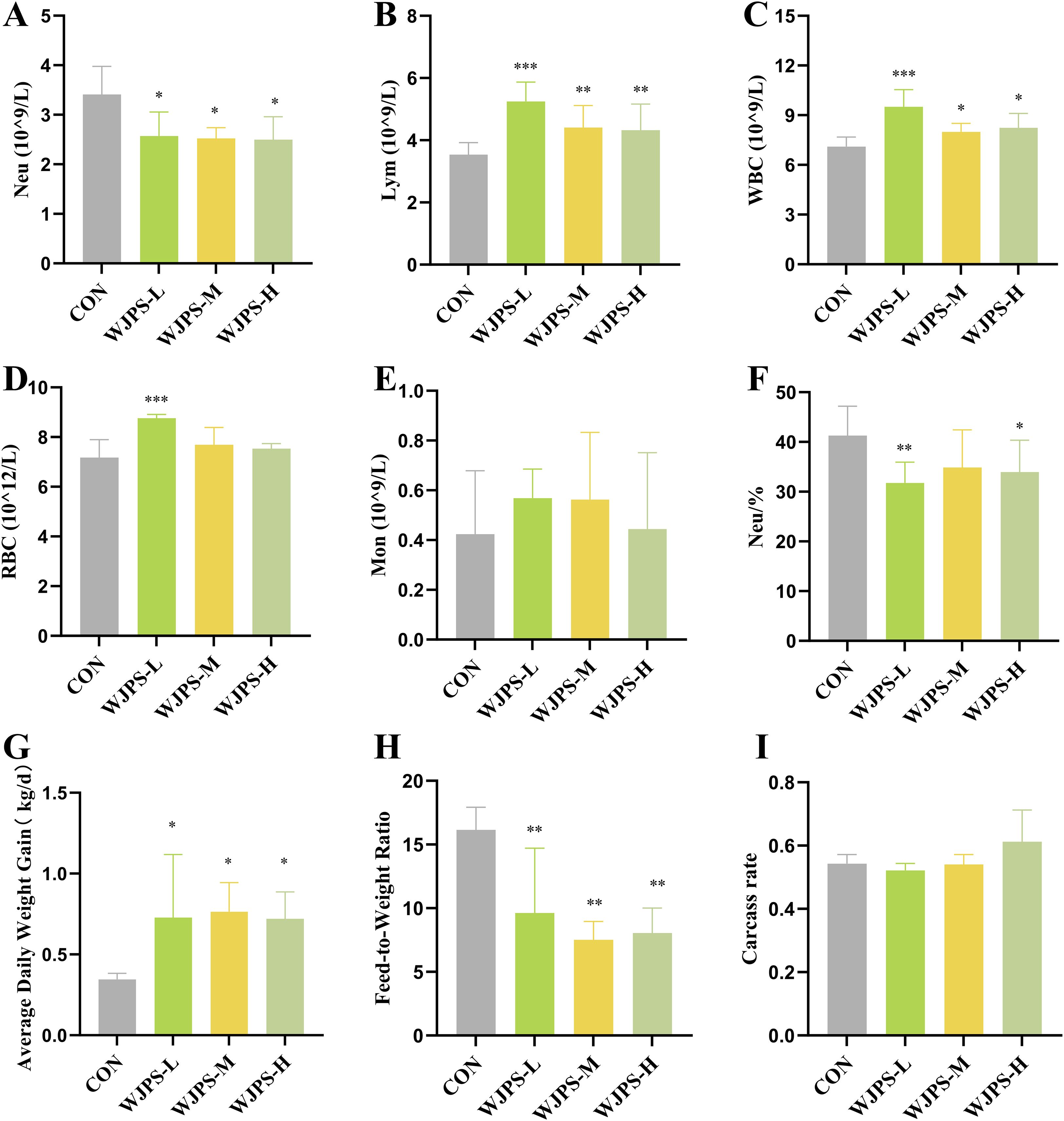
Figure 1. Effect of WJPS on routine blood index in yaks. (A) Neutrophil number; (B) Lymphocyte number; (C) Leukocyte number; (D) Erythrocyte number; (E) Monocyte number; (F) Percentage of neutrophils; (G) Average daily weight gain; (H) Feed-to-weight ratio; and (I) Carcass rate. Data are expressed as mean ± SD (n=6); * indicates statistically significant difference compared with CON group: *P<0.05 indicates statistically significant difference; **P<0.01 indicates significant difference; ***P<0.001 indicates highly significant difference.
3.2 Effect of WJPS on the histomorphology of yaks
The ileum samples of the four groups showed a relatively complete structure of the mucosal layer, submucosal layer, muscularis propria and outer membrane, and the intestinal villi were neatly arranged; the colon samples of the four groups showed neatly arranged epithelial cells, and the structure of the submucosal layer, the mucosal muscularis propria, the inner circular muscle and the outer longitudinal muscle was complete, with no obvious pathological changes, such as denaturation, edema, and inflammation(Figure 2).
3.3 Effects of WJPS on serum antioxidant and immune functions in yaks
As shown in Figure 3, compared with the CON group, the expression of IgG, IL-2 and SOD in the WJPS-L group was highly significantly increased (P < 0.001), the content of IgM and IL-8 was significantly increased (P < 0.01), and the expression of IgA and GSH-PX was increased (P < 0.05); in the WJPS-M group, the expression of IgG, IL-2, IgA, GSH-PX, IL-8 content was more significantly increased (P < 0.01), and SOD content was highly significantly increased (P < 0.001); the WJPS-H group significantly increased the expression of SOD (P < 0.01), and increased the expression of IgM and GSH-PX (P < 0.05). Comparative analysis of differences between groups showed that the expression of TNF-α in the WJPS groups was similar to that in the CON group, with no statistical difference (P > 0.05). It indicated that WJPS could improve the immune function and antioxidant capacity of yaks.
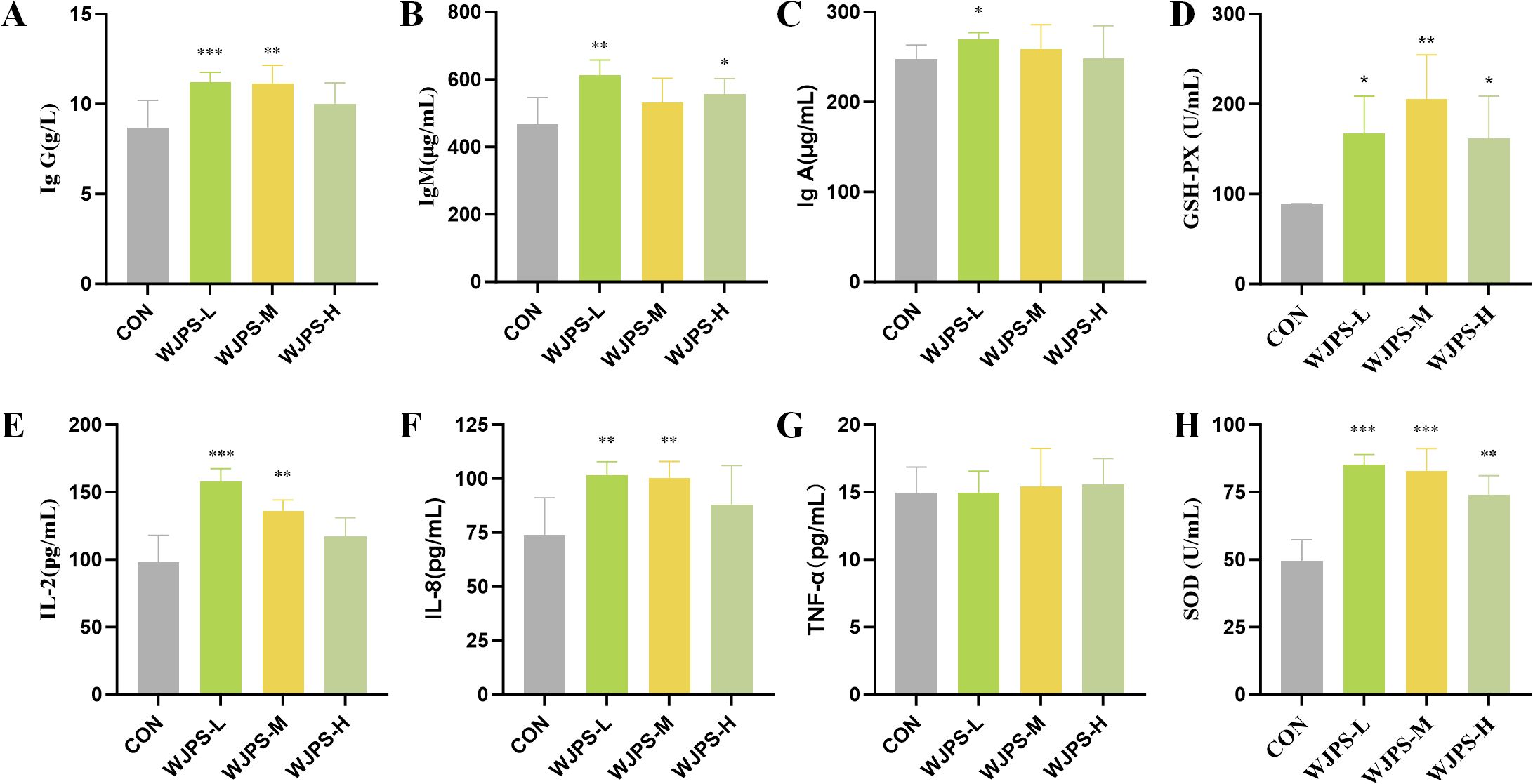
Figure 3. Effect of WJPS on serum immunity and antioxidant levels in yaks. (A) serum IgG level; (B) serum IgM level; (C) serum IgA level; (D) serum GSH-PX level; (E) serum IL-2 level; (F) serum IL-8 level; (F) serum TNF-α level; (F) serum SOD level. * indicates statistically significant difference compared with CON group: * P<0.05 indicates statistically significant difference; **P<0.01 indicates significant difference; ***P<0.001 indicates highly significant difference.
3.4 Effect of WJPS on the composition and function of intestinal microbiota in yaks
As shown in Figures 4A-D, compared with the CON group, the Chao, Shannon and ACE indices of the WJPS-M and WJPS-H groups were slightly decreased and the Simpson index was increased, while the Chao, Shannon and ACE indices of the WJPS-L group were increased and the Simpson index was decreased. It indicates that the sample flora of CON and WJPS-L groups had the highest community richness, while the community diversity of the samples of WJPS-H group was higher than the diversity of the other groups. As shown in Figure 4 E, the principal coordinate analysis (PCoA) based on the Bray-Curtis difference at the Phylum level, the CON, WJPS-L, WJPS-M, and WJPS-H groups were in segregated states, indicating that the gut microbiota of the four sample groups differed but the effect of the difference was not significant (P > 0.05). The composition of the gut microbiota was summarized using a Venn diagram (Figure 4F). The numbers of OTUs unique to the CON, WJPS-L, WJPS-M, and WJPS-H groups were 1,074, 857, 422, and 686, respectively. A total of 15,792 OTUs were shared among all four groups. As shown in Figure 4 G, at the phylum level, the composition of the colony was dominated by Firmicutes, Bacteroidota and Pseudomonadota. Compared with the CON group, groups WJPS-L and WJPS-H increased the relative abundance of Firmicutes(P > 0.05), groups WJPS-L and WJPS-M increased the relative abundance of Bacteroidota(P > 0.05), and groups WJPS-L, WJPS-M, and WJPS-H decreased the relative abundance of Pseudomonadota(P > 0.05). At the genus level (Figure 4H), the four groups of samples were mainly composed of Ruminococcus, Alistipes, Bacteroides, Staphylococcus, and Methanobrevibacter(P > 0.05). Compared with the CON group, the WJPS-L group increased the relative abundance of beneficial bacteria such as Ruminococcus, Alistipes, Bacteroides, and Treponema decreased the relative abundance of pathogenic bacteria such as Staphylococcus and Streptococcus(P > 0.05). It suggests that WJPS can regulate the microbiota balance by altering the gut microbiota abundance, and thus maintain gut homeostasis.
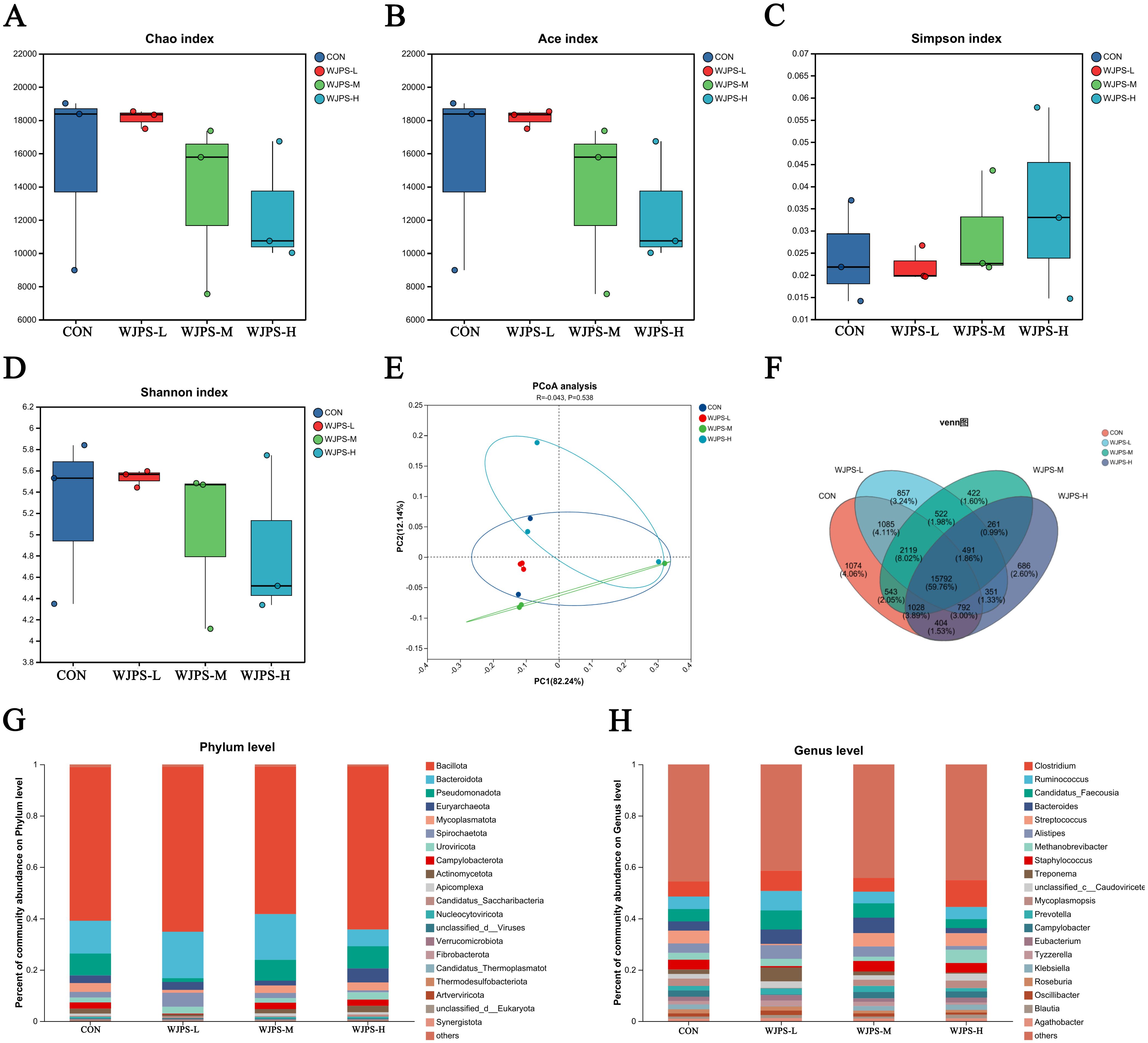
Figure 4. Effect of WJPS on intestinal microbiota of yaks. (A–D) Grouped boxplots of the AlPha diversity index; (E) 2D ordination plot of samples from PCoA analysis of Beta diversity; (F) Wayne’s diagrams; (G) distribution of phylum-level taxonomic composition; (H) distribution of species-level taxonomic composition. Data are expressed as mean ± SD (n=3).
LEfSe analysis was performed, and LDA scores (>2) were derived from LEfSe analysis to identify several bacteria that differentiated the CON from the WJPS-L and WJPS-H groups (Figure 5A). The CON group showed enrichment of Negativicutes and Roseburia; the WJPS-L group exhibited a significant increase in Treponema abundance (P<0.05); and the WJPS-H group demonstrated a significant increase in Ruminobacter abundance (P<0.05). KEGG pathway analysis was performed(Figure 5B) to explore potential differences in the functional composition of the microbiomes of each group, and the top ten mean proportion KEGG pathways were selected, with the highest mean proportion of Metabolic pathways, and the WJPS groups in Biosynthesis of secondary metabolites, Microbial metabolism in diverse environments, Biosynthesis of amino acids, Biosynthesis of cofactors, Carbon metabolism, ABC transporters, Two- component system and Purine metabolism were slightly higher than that in the CON group and highest in the WJPS-L group. WJPS can change the composition of the gut microbiota in yaks and can regulate the function of the gut microbiota to further maintain the homeostasis of the intestinal environment in yaks. WJPS can change the composition of the gut microbiota in yaks and can regulate the function of the gut microbiota to further maintain the homeostasis of the intestinal environment in yaks.
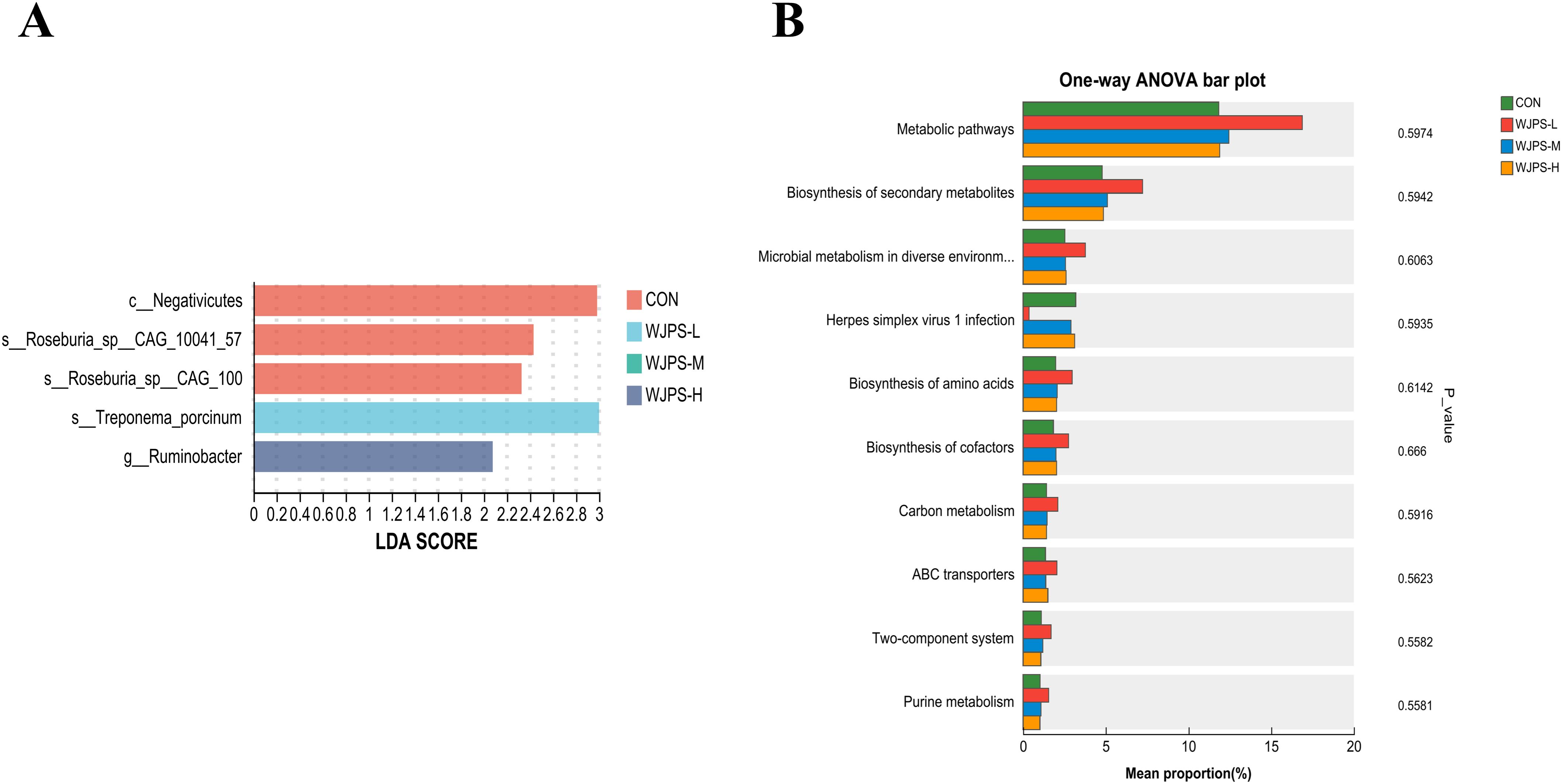
Figure 5. Effect of WJPS on the composition and function of intestinal microbiota in yaks. (A) LEfSe analysis of differences in fecal bacterial enrichment at species level (linear discriminant analysis [LDA] >2); (C) graph of results of KEGG enrichment analysis.
3.5 Effect of WJPS on bile acid metabolism level in yaks
The results of the bile acid metabolism of yaks intestinal contents showed that the total bile acid content of the WJPS groups increased compared with the CON group(Figure 6A), but there was no statistically significant difference (P > 0.05); the results of the Partial Least Squares Discriminant Analysis (PLS-DA) showed that there was a significant separation between the CON group and the WJPS-L group, and some differences with the WJPS-M and WJPS-H groups (Figures 6B–D). As shown in Figures 6E–K, the content of Glycochenodeoxycholic acid, Glycoursodeoxycholic acid, Alpha-muricholic acid and Murideoxycholic acid were significantly increased in the WJPS-L group (P < 0.05), the content of Taurocholic acid and Cholic acid were significantly decreased (P < 0.01); Taurodeoxycholic acid and Taurocholic acid were significantly decreased (P < 0.05) in WJPS-M and WJPS-H groups.
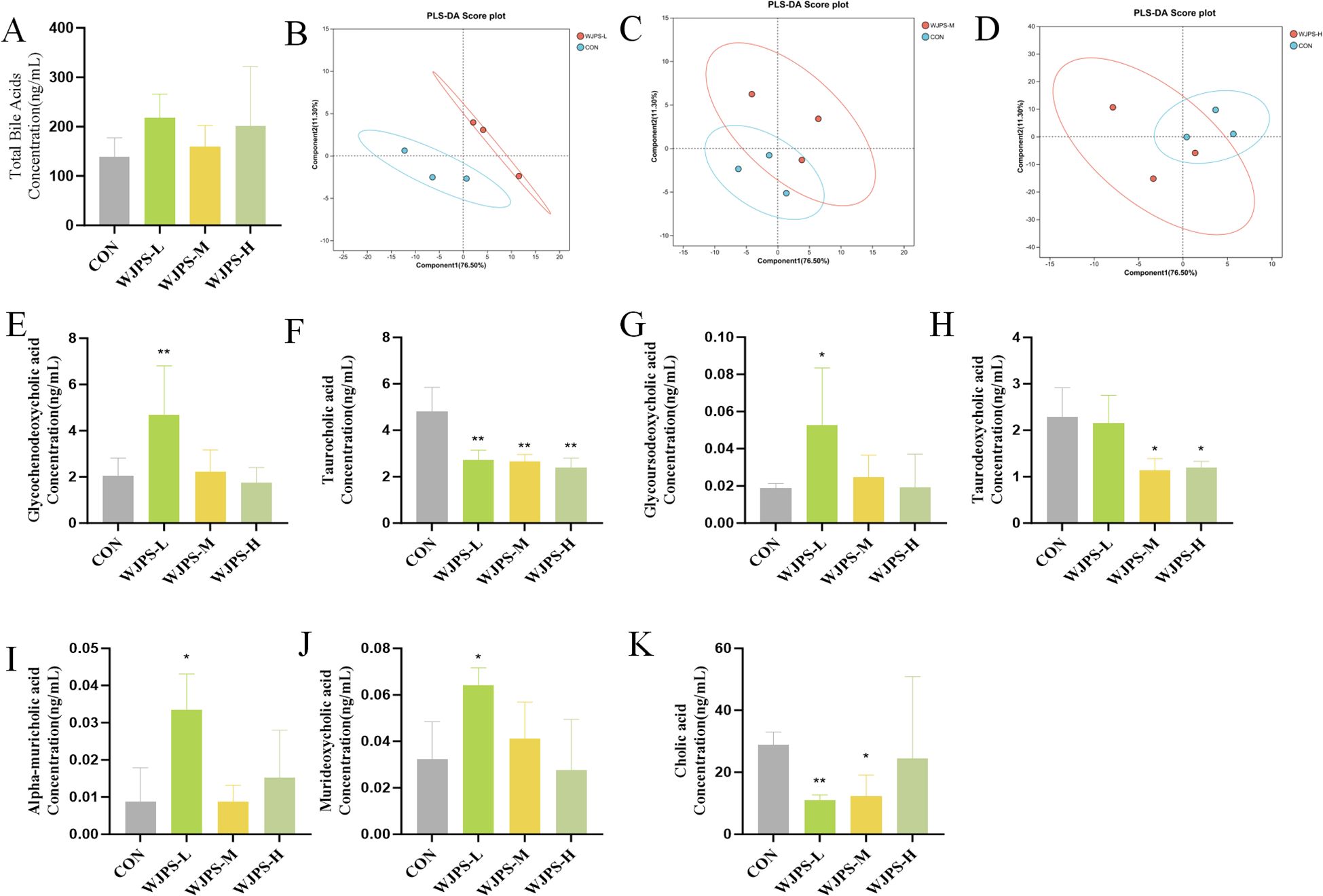
Figure 6. Effect of WJPS on bile acid metabolism in intestinal contents of yaks. (A) Total bile acid content of samples from the 4 groups; (B–D) PLS-DA score plots of the CON group versus the WJPS-L, WJPS-M, and WJPS-H groups; (E–K) Significantly altered quantitative abundance of BAs in the different groups, including Glycochenodeoxycholic acid, Taurocholic acid, Glycoursodeoxycholic acid, Alpha-muricholic acid, Murideoxycholic acid, Taurodeoxycholic acid, and Cholic acid.* denotes statistically significant difference in comparison with CON group: * P<0.05 denotes statistically significant difference; **P<0.01 indicates significant difference.
3.6 Expression levels of genes related to bile acid metabolism in yaks by WJPS
As shown in Figure 7, compared with the CON group, the WJPS-L group increased the expression of FXR in the colon of yaks (P < 0.05); the WJPS-L, WJPS-M, and WJPS-H groups significantly decreased the expression of IL-17A and IL-1β in the colon of yaks (P < 0.01); the WJPS-L and WJPS-M groups decreased the colonic IL-10 expression (P < 0.05); WJPS-L, WJPS-M and WJPS-H groups decreased the expression of Cyp7A1 in the colon (P < 0.05).WJPS reduces the expression of inflammatory factors in tissues by upregulating FXR mRNA levels and downregulating CYP7A1 mRNA levels.
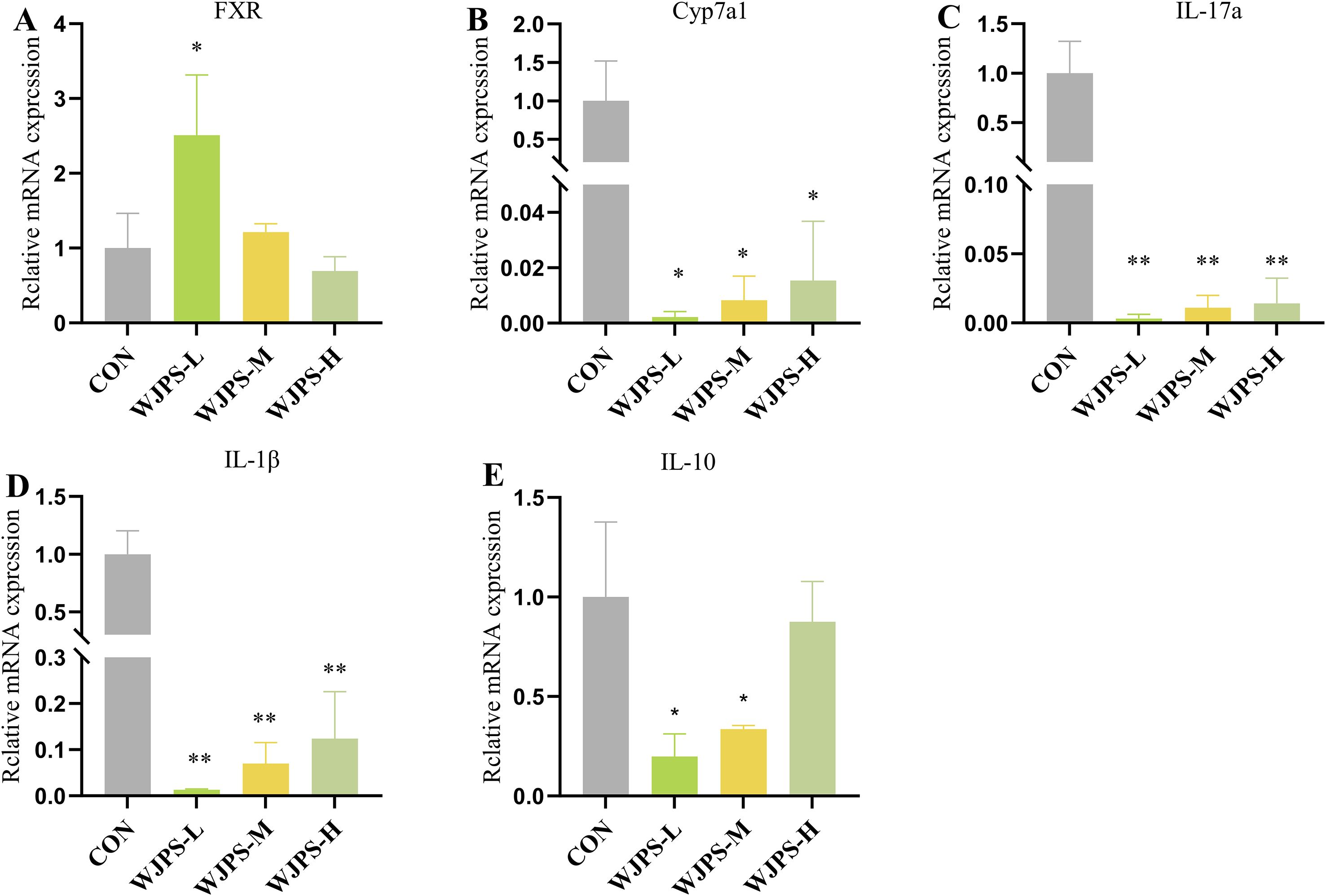
Figure 7. Effect of WJPS on gene expression levels related to bile acid metabolism in yaks. (A–E) mRNA expression levels of FXR, Cyp7a1, IL-17A, IL-1β and IL-10 in the colon of yaks in the 4 groups. * indicates statistically significant difference compared with CON group: * P<0.05 indicates statistically significant difference; **P<0.01 indicates significant difference.
3.7 Correlation analysis between bile acid metabolism and relative abundance of gut microbiota
To investigate the relationship between gut microbes and bile acid metabolism, additional Spearman correlation analyses were performed in this study to better understand these interactions. As shown in the Figure 8, Cholic acid and 7-ketodeoxycholic acid were significantly negatively correlated with Tyzzerella, Treponema, Ruminococcus, Prevotella, Bacteroides and Alistipes; Murideoxycholic acid was significantly positively correlated with Tyzzerella, Treponema, Ruminococcus, Prevotella, Bacteroides, and Alistipes; 12-ketolithocholic acid was significantly positively correlated with Tyzzerella, Treponema, Prevotella, Bacteroides and Alistipes were significantly positively correlated;Isolithocholic acid was significantly positively correlated with Tyzzerella, Treponema, Prevotella, and Bacteroides; Alpha-muricholic acid with Tyzzerella, Treponema, Ruminococcus, Clostridium, Methanobrevibacter, and Alistipes. The results suggest that WJPS can influence the expression of bile acid metabolites by modulating the abundance of gut microorganisms.
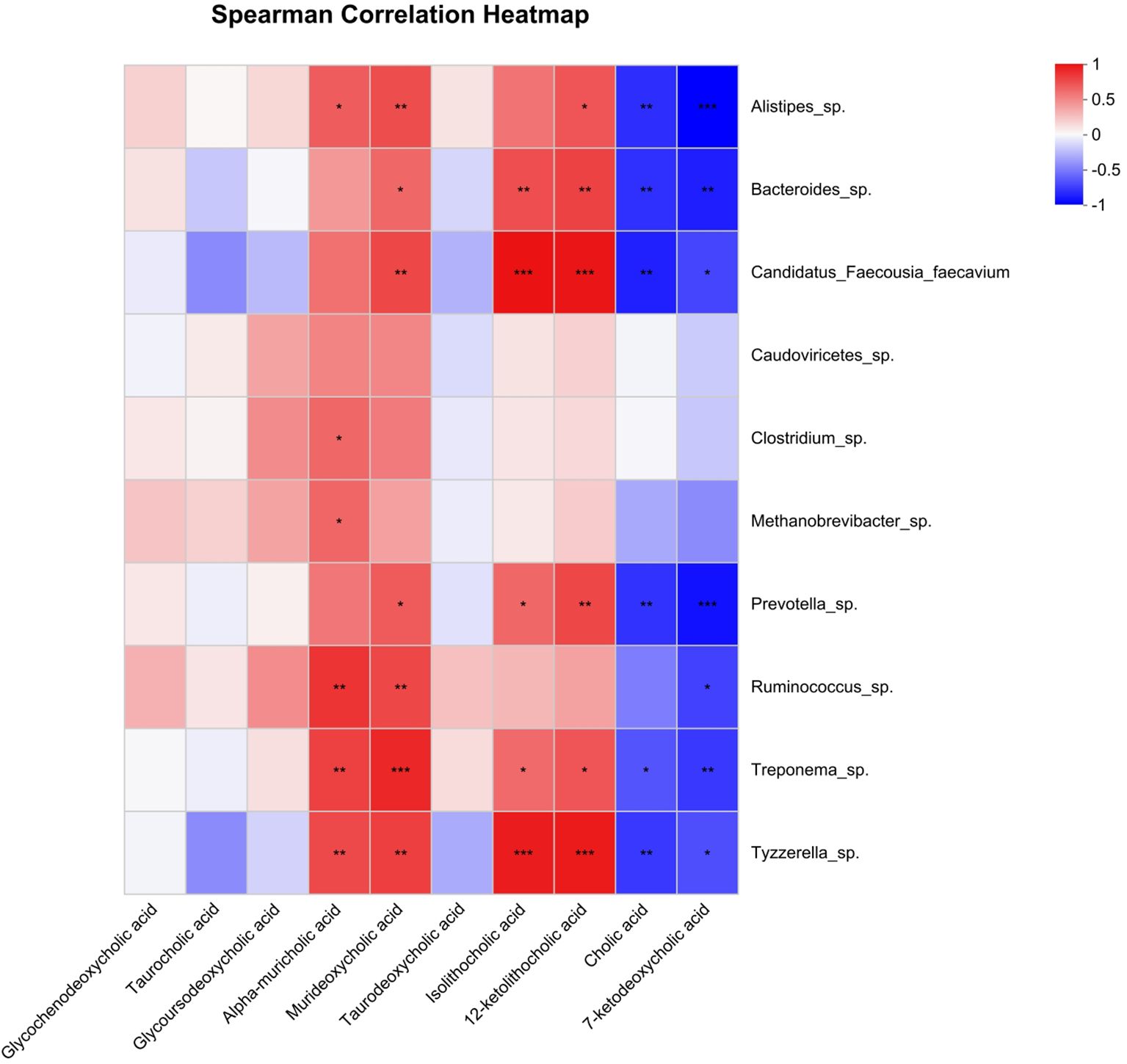
Figure 8. Spearman’s correlation between intestinal microbiota and bile acids in yaks. Red color represents positive correlation and green color represents negative correlation. The intensity of the colors is proportional to the strength of the Spearman correlation. * P<0.05 indicates statistically significant difference; **P<0.01 indicates significant difference; ***P<0.001 indicates highly significant difference.
4 Discussion
The current study comprehensively elucidates that a 90-day dietary supplementation of WJPS in yaks not only significantly enhances growth performance, immune function, but also modulates the physiological oxygen demand. These improvements are intricately associated with a profound transformation in the gut microbiota composition. Specifically, there is a notable proliferation of beneficial bacteria, such as Ruminococcus and Alistipes, while the abundance of pathogenic species, including Staphylococcus and Streptococcus, is markedly reduced. Notably, WJPS elicits a remarkable reprogramming of bile acid metabolism. It leads to an elevation in GCDCA and GUDCA levels, while simultaneously decreasing TCA and CA concentrations. Mechanistically, WJPS upregulates the mRNA expression of the FXR while downregulating that of CYP7A1, suggesting its crucial regulatory role in maintaining bile acid homeostasis. Furthermore, WJPS suppresses the expression of inflammatory cytokines, which is pivotal for preserving intestinal barrier integrity and overall metabolic health.
4.1 Growth performance and blood physiology
Growth performance serves as a pivotal parameter for evaluating an organism’s growth status. Accumulating evidence from previous studies (Guan et al., 2024), has demonstrated that the incorporation of herbal supplements can effectively increase the average daily weight gain, decrease the feed-to-weight ratio, and accelerate the overall body weight growth rate. These findings are highly consistent with our results, further validating that herbal supplementation, particularly WJPS, can significantly improve animal growth performance.
Blood parameters act as indispensable biomarkers reflecting the metabolic and immunological status of an organism (Xu et al., 2025). In line with earlier reports (Achmad Hamzah et al., 2012), the administration of WJPS led to a significant increase in leukocyte, lymphocyte, and erythrocyte counts, providing robust evidence for its immunomodulatory effects. This indicates that WJPS not only promotes physical growth but also fortifies the immune system at the cellular level.
4.2 Antioxidant and immune modulation
Oxidative stress exerts far-reaching and multifaceted impacts on immune function (Salak-Johnson and McGlone, 2007). Consequently, interventions aimed at enhancing antioxidant defenses are essential for maintaining immune homeostasis. The present study reveals that WJPS supplementation substantially improves the antioxidant capacity and immune responses in yaks. This is evident from the significant elevation in the activities of SOD and GSH-Px. SOD functions as the first line of defense against oxidative damage by catalyzing the dismutation of superoxide radicals (O2-) into less reactive hydrogen peroxide (H2O2) (Chi et al., 2025). Subsequently, GSH-Px further detoxifies peroxides, including H2O2 and lipid hydroperoxides, thereby playing a crucial role in maintaining cellular redox balance and preventing oxidative injury (Anajirih et al., 2024). These enzymatic antioxidants are not only vital for mitigating oxidative stress but also for supporting the normal function of immune cells. Specifically, SOD modulates inflammatory responses by regulating reactive oxygen species (ROS)-dependent signaling pathways, while GSH-Px safeguards immune cells from peroxidative damage, ensuring optimal immune surveillance (Hu et al., 2023).
Moreover, WJPS supplementation significantly increased immunoglobulin (Ig) levels, indicating a marked enhancement of humoral immunity. This finding aligns well with previous research. For instance, Astragalus polysaccharides have been reported to elevate serum GSH-Px and SOD levels in calves (Zhang et al., 2024); compound Chinese herbs have been shown to augment antioxidant enzyme activities in broilers (Guo et al., 2020); and Codonopsis-containing formulations have been demonstrated to improve serum immune factors (Xia et al., 2025). Extensive studies (Chen et al., 2021) have further confirmed that herbal compounds can stimulate the development of immune organs, such as the spleen and thymus, and promote the secretion of cytokines, including IL-2 and IFN-γ, thereby enhancing both innate and adaptive immunity.
In summary, the observed upregulation of SOD, GSH-Px, and immunoglobulins highlights the dual functions of WJPS: 1) it effectively ameliorates oxidative stress by scavenging ROS through enzymatic mechanisms; 2) it strengthens immune competence by promoting antibody production and modulating cytokine expression. These effects collectively contribute to improved disease resistance and metabolic health in yaks, firmly establishing WJPS as a promising phytogenic supplement for livestock.
4.3 Gut microbiota-bile acid metabolic axis
This study employed Spearman correlation analysis to reveal significant associations between gut microorganisms and bile acid metabolites under WJPS intervention. Key findings indicate that short-chain fatty acid-producing bacteria, such as Prevotella, Bacteroides, and Alistipes, showed negative correlations with primary bile acids (e.g., cholic acid) but positive correlations with secondary bile acids (e.g., murideoxycholic acid, 12-ketolithocholic acid). This opposing correlation pattern strongly suggests that WJPS promotes the proliferation of microbial taxa with bile salt hydrolase (BSH) activity, thereby enhancing the microbial biotransformation of primary to secondary bile acids.
Notably, genera such as Ruminococcus and Tyzzerella also demonstrated positive correlations with secondary bile acids, further supporting microbial conversion as a core mechanism reshaping the bile acid pool. These results directly complement our earlier findings that WJPS modulates the gut microbiota structure to alter the bile acid metabolic profile. In summary, we propose a central pathway: WJPS → enriches specific functional bacteria → enhances bile acid biotransformation → alters bile acid composition → subsequently mediates physiological effects. This provides critical evidence elucidating the mechanism of action of WJPS.
The gut microbiome plays a central and indispensable role in regulating intestinal homeostasis. It orchestrates a series of essential physiological processes through intricate interactions with mucosal barriers, immune networks, and metabolic pathways (Ji et al., 2025; Jiang et al., 2024). Emerging evidence has underscored the significant correlation between the stability of the microbial community and the overall health of the host, with the Firmicutes-to-Bacteroidetes ratio being particularly emphasized as a key indicator of intestinal ecosystem balance (Lewandowska-Pietruszka et al., 2023). Disruptions to this microbial equilibrium are often associated with impaired digestive function, compromised barrier integrity, and an increased susceptibility to systemic inflammatory conditions.
Our findings indicate that WJPS exerts profound modulatory effects on the gut microbial composition. It notably enriches beneficial taxa, such as Ruminococcus, Alistipes, Bacteroides, and Treponema, while suppressing potentially pathogenic genera, including Staphylococcus and Streptococcus. This microbial remodeling is consistent with previous observations that phytogenic compounds can positively reshape gut microbiota profiles (Li S. et al., 2024). Of particular importance is the WJPS-induced enrichment of Ruminococcus species, which may contribute to the reinforcement of mucosal barriers and immune regulation. Additionally, the expansion of Bacteroides populations is likely to enhance polysaccharide fermentation and short-chain fatty acid production (Li Z. et al., 2024).
The influence of the gut microbiota on bile acid metabolism is profound and operates through a complex biochemical cascade. Primary bile acids are conjugated with glycine or taurine via the actions of bile acid-CoA synthase and amino acid transferase (Kiriyama and Nochi, 2022). Bacteria expressing bile salt hydrolase (BSH), such as Bacteroides, Lactobacillus, and Clostridium, facilitate deconjugation (Hui et al., 2019). Moreover, 7α-dehydroxylase from specific anaerobic bacteria, such as Clostridium and Eubacterium, converts primary bile acids into secondary bile acids (Thibaut et al., 2025). Subsequent modifications lead to the generation of diverse bile acid species with distinct signaling properties (Sun et al., 2022).
At the core of this regulatory network is the FXR, which plays several critical roles. It maintains intestinal epithelial integrity (Matsuzaki et al., 2013), governs bile acid homeostasis through negative feedback on CYP7A1 (Qi et al., 2024), and serves as a molecular bridge between the microbiota and host metabolism (Xiong et al., 2018). Our data indicate that WJPS administration significantly altered the bile acid profile, characterized by a reduction in primary bile acids (TCA, CA), an increase in secondary/tertiary bile acids (GCDCA, GUDCA, αMCA, MDCA), upregulated expression of FXR, and downregulated expression of CYP7A1. These metabolic shifts suggest that WJPS promotes a favorable composition of the bile acid pool, which supports intestinal barrier protection, exerts anti-inflammatory effects, stabilizes the microbial ecosystem, and enhances nutrient absorption. The coordinated modulation of both microbial communities and bile acid metabolism positions WJPS as a promising intervention for optimizing gut-liver axis function and overall metabolic health in ruminants.
5 Conclusion
Wuwei Jianpi San can improve the growth performance, antioxidant capacity and immune function of yaks, and maintain intestinal homeostasis by modifying the composition of intestinal microorganisms and regulating bile acid metabolism. The results of this study suggest that the addition of 0.5% of Wuwei Jianpi San to concentrate is the optimal dose for future animal husbandry.
These findings firmly establish WJPS as a promising phytogenic feed additive for livestock, presenting a natural and effective strategy to enhance productivity and disease resistance. Future research should focus on exploring its long-term effects and potential applications in other ruminant species, which may further expand its utility in sustainable livestock production.
Data availability statement
The data presented in the study are deposited in the NCBI SRA repository, accession number PRJNA1245595.
Ethics statement
The animal studies were approved by Animal Ethics Committee of Gansu Agricultural University (GSAU-Eth-VMC-2024-054). The studies were conducted in accordance with the local legislation and institutional requirements. Written informed consent was obtained from the owners for the participation of their animals in this study.
Author contributions
JK: Conceptualization, Formal Analysis, Investigation, Methodology, Software, Supervision, Writing – original draft. CN: Resources, Writing – original draft. KZ: Investigation, Visualization, Writing – original draft. XY: Investigation, Visualization, Writing – original draft. YH: Resources, Supervision, Writing – review & editing. YW: Software, Validation, Writing – review & editing. PJ: Conceptualization, Writing – review & editing. LZ: Software, Validation, Writing – review & editing. XK: Investigation, Visualization, Writing – review & editing. HC: Writing – review & editing.
Funding
The author(s) declare financial support was received for the research and/or publication of this article. China Agriculture Research System of MOF and MARA (CARS-37, CARS-07G-13), Fuxi Foundation of Gansu Agricultural University (No. Gaufx-03J01), Gansu Provincial Key Research and Development Program -Agriculture Field (24YFNA016), Modern Cold and Drought Characteristic Agricultural Science and Technology Support Project of Gansu Province (KJZC-2025-14).
Acknowledgments
We are thankful for the support of this work by the College of Veterinary Medicine, Gansu Agricultural University.
Conflict of interest
The authors declare that the research was conducted in the absence of any commercial or financial relationships that could be construed as a potential conflict of interest.
Generative AI statement
The author(s) declare that no Generative AI was used in the creation of this manuscript.
Any alternative text (alt text) provided alongside figures in this article has been generated by Frontiers with the support of artificial intelligence and reasonable efforts have been made to ensure accuracy, including review by the authors wherever possible. If you identify any issues, please contact us.
Publisher’s note
All claims expressed in this article are solely those of the authors and do not necessarily represent those of their affiliated organizations, or those of the publisher, the editors and the reviewers. Any product that may be evaluated in this article, or claim that may be made by its manufacturer, is not guaranteed or endorsed by the publisher.
Abbreviations
WJPS, Wuwei Jianpi San; GSH-Px, Glutathione peroxidase; SOD, Superoxide dismutase; TNF-α, Tumor Necrosis Factor – α; IL-8, Interleukin-8; IL-2, Interleukin-2; IgA, Immunoglobulin A; IgG, Immunoglobulin G; IgM, Immunoglobulin M; FXR, Farnesoid X Receptor; CYP7A1, Cytochrome P450 Family 7 Subfamily A Member 1; IL-17A, Interleukin-17A; QPCR, Quantitative Polymerase Chain Reaction; Lym, Lymphocyte; RBC, Red blood cell; WBC, White blood cell; IL-1β, Interleukin-1β; IL-6, Interleukin-6.
References
Achmad Hamzah R., Wiryanti I., Apri Astuti D., Satrija F., and Fisiologi Departemen Anatomi Fisiologi dan Farmakologi L. (2012). Tanggap Kebal dan Tampilan Produksi Ayam Pedaging yang Diberi Ekstrak Buah Mengkudu. J. Vet. 13, 34–42.
Anajirih N., Abdeen A., Taher E. S., Abdelkader A., Abd-Ellatieff H. A., Gewaily M. S., et al. (2024). Alchemilla vulgaris modulates isoproterenol-induced cardiotoxicity: interplay of oxidative stress, inflammation, autophagy, and apoptosis. Front. Pharmacol. 15. doi: 10.3389/fphar.2024.1394557
Chandra Shekhara M., Johan Van N., Vidul M., Sonali J., Ashish S., Austin A., et al. (2020). Role of bile acids and gut microbiota in parenteral nutrition associated injury. J. Hum. Nutr. 4. doi: 10.36959/487/286
Chen Q., Ren R., Zhang Q., Wu J., Zhang Y., Xue M., et al. (2021). Coptis chinensis Franch polysaccharides provide a dynamically regulation on intestinal microenvironment, based on the intestinal flora and mucosal immunity. J. Ethnopharmacol 267, 2396–2396. doi: 10.1016/j.jep.2020.113542
Chi F., Cheng C., Liu K., Sun T., Zhang M., Hou Y., et al. (2025). Baicalein disrupts the KEAP1-NRF2 interaction to alleviate oxidative stress injury by inhibiting M1 macrophage polarization. Free Radic. Biol. Med. 227, 557–569. doi: 10.1016/j.freeradbiomed.2024.12.036
Guan Y., Zheng W., Bai Y., and Wu B. (2024). Yupingfeng polysaccharide promote the growth of chickens via regulating gut microbiota. Front. Vet. Sci. 11. doi: 10.3389/fvets.2024.1337698
Guo S., Ma J., Xing Y., Xu Y., Jin X., Yan S., et al. (2020). Artemisia annua L. aqueous extract as an alternative to antibiotics improving growth performance and antioxidant function in broilers. Ital. J. Anim. Sci. 19, 399–409. doi: 10.1080/1828051X.2020.1745696
Hu F., Yan B., Xue Z., Lu M., Diao Q., Tu Y., et al. (2023). Effect of baicalin supplementation on the growth, health, antioxidant and anti-inflammatory capacity, and immune function of preweaned calves. Anim. Feed Sci. Technol. 298. doi: 10.1016/j.anifeedsci.2023.115598
Hui S., Liu Y., Chen M., Wang X., Lang H., Zhou M., et al. (2019). Capsaicin improves glucose tolerance and insulin sensitivity through modulation of the gut microbiota-bile acid-FXR axis in type 2 diabetic db/db mice. Mol. Nutr. Food Res. 63, e1900608. doi: 10.1002/mnfr.201900608
Ji W., Kim T. Y., Lee C. W., Kim Z. H., Jung J. Y., Ban B. C., et al. (2025). Supplementation of Parachlorella sp. in feed promote the gut microbiome colonization and fecal IgA response of broiler in both early and late period. Poult. Sci. 104, 104572. doi: 10.1016/j.psj.2024.104572
Jiang C., Chen W., Yang Y., Li X., Jin M., Ghonaim A. H., et al. (2024). Regulation of isoleucine on colonic barrier function in rotavirus-infected weanling piglets and analysis of gut microbiota and metabolomics. Microorganisms 12(12), 2396–2396. doi: 10.3390/microorganisms12122396
Kiriyama Y. and Nochi H. (2022). Physiological role of bile acids modified by the gut microbiome. Microorganisms. 10 (1), 68–68. doi: 10.3390/microorganisms10010068
Lei S., Li X., Liu L., Zheng M., Chang Q., Zhang Y., et al. (2020). Effect of lotus seed resistant starch on tolerance of mice fecal microbiota to bile salt. Int. J. Biol. Macromol. 151, 384–393. doi: 10.1016/j.ijbiomac.2020.02.197
Lewandowska-Pietruszka Z., Figlerowicz M., and Mazur-Melewska K. (2023). Microbiota in autism spectrum disorder: A systematic review. Int. J. Mol. Sci. 24. doi: 10.3390/ijms242316660
Li S., Li S., Liu S., Lu S., Li J., Cheng S., et al. (2024). Portulaca oleracea exhibited anti-coccidian activity, fortified the gut microbiota of Hu lambs. AMB Express 14(1), 50–50. doi: 10.1186/s13568-024-01705-4
Li Z., Ma N., Gong X., Shi W., Meng X., Yan J., et al. (2024). Effects of herbal dregs supplementation of Salvia miltiorrhiza and Isatidis Radix residues improved production performance and gut microbiota abundance in late-phase laying hens. Front. Vet. Sci. 11, 1381226–1381226. doi: 10.3389/fvets.2024.1381226
Li Y., Sun T., Hong Y., Qiao T., Wang Y., Li W., et al. (2021). Mixture of five fermented herbs (Zhihuasi tk) alters the intestinal microbiota and promotes the growth performance in piglets. Front. Microbiol. 12, 725196–725196. doi: 10.3389/fmicb.2021.725196
Matsuzaki J., Suzuki H., Tsugawa H., Watanabe M., Hossain S., and Arai E. (2013). Bile acids increase levels of microRNAs 221 and 222, leading to degradation of CDX2 during esophageal carcinogenesis. Gastroenterology 145, 1300–1311. doi: 10.1053/j.gastro.2013.08.008
Qi Y., Ma Y., and Duan G. (2024). Pharmacological mechanisms of bile acids targeting the farnesoid X receptor. Int. J. Mol. Sci. 25 (24), 13656–13656. doi: 10.3390/ijms252413656
Salak-Johnson J. L. and McGlone J. J. (2007). Making sense of apparently conflicting data: stress and immunity in swine and cattle. J. Anim. Sci. 85 (S13), E81–8. doi: 10.2527/jas.2006-538
Shen M., Zhao H., Han M., Su L., Cui X., Li D., et al. (2024). Alcohol-induced gut microbiome dysbiosis enhances the colonization of Klebsiella pneumoniae on the mouse intestinal tract. mSystems 9, e0005224–e0005224. doi: 10.1128/msystems.00052-24
Sun J., Fan J., Li T., Yan X., and Jiang Y. (2022). Nuciferine protects against high-fat diet-induced hepatic steatosis via modulation of gut microbiota and bile acid metabolism in rats. J. Agric. Food Chem. 70, 12014–12028. doi: 10.1021/acs.jafc.2c04817
Thibaut M. M., Roumain M., Piron E., Justine G., Axelle L., Audrey M. N., et al. (2025). The microbiota-derived bile acid taurodeoxycholic acid improves hepatic cholesterol levels in mice with cancer cachexia. Gut Microbes 17, 2449586. doi: 10.1080/19490976.2025.2449586
Wang X. (2016). Clinical observation of astragalus jianzhong decoction in treating digestive dysfunction in diabetic patients. New World Diabetes 19, 37–38. doi: 10.16658/j.cnki.1672-4062.2016.10.037
Xia Z., Li G., Zhai Y., Tong L., Ru Y., Wu M., et al. (2025). Immunomodulatory effects and multi-omics analysis of Codonopsis Pilosula Extract in septic rats. J. Ethnopharmacol 337(P2), 118847. doi: 10.1016/j.jep.2024.118847
Xiong F., Wu S. G., Zhang J., Jakovlic I., Li W. X., Zou H., et al. (2018). Dietary bile salt types influence the composition of biliary bile acids and gut microbiota in grass carp. Front. Microbiol. 9, 2209. doi: 10.3389/fmicb.2018.02209
Xu S., Wu Y., Wang Y., Li Y., He Y., Ren L., et al. (2025). Huanglian Ganjiang Decoction alleviates DSS-induced colitis through suppressing inflammation and protecting intestinal barrier: From the perspective of disassembling prescriptions. J. Ethnopharmacol 341, 119340. doi: 10.1016/j.jep.2025.119340
Yang X., Bu X., Li Y., Shen R., Duan Y., Liu M., et al. (2024). Effects of oxidative stress and protein S-nitrosylation interactions on mitochondrial pathway apoptosis and tenderness of yak meat during postmortem aging. Food Res. Int. 191, 114717–114717. doi: 10.1016/j.foodres.2024.114717
Zang R., Zhou R., Li Y., Liu Z., Wu H. H., Lu L. P., et al. (2025). Oleuropein regulates bile acid metabolism via modulating the gut microbiota, thereby alleviating DSS-induced ulcerative colitis in mice. Foods 14, 1863–1863. doi: 10.3390/foods14111863
Zhang M., Geng W., Guan X., Gao S., and Mao J. (2024). Antioxidant and anti-inflammatory effects of different ratios and preparations of Angelica sinensis and chuanxiong rhizoma extracts. J. Ethnopharmacol 334, 118559. doi: 10.1016/j.jep.2024.118559
Keywords: Wuwei Jianpi San, growth performance, immune function, intestinal microbiota, bile acid metabolism
Citation: Kang J, Niu C, Zhou K, Yang X, Hua Y, Wei Y, Ji P, Zhang L, Kong X and Che H (2025) Gut microbiome and metabolome remodeling by Wuwei Jianpi San enhances growth and immunity in yaks: a multi-omics approach. Front. Anim. Sci. 6:1670191. doi: 10.3389/fanim.2025.1670191
Received: 21 July 2025; Accepted: 06 October 2025;
Published: 29 October 2025.
Edited by:
P. K. Malik, National Institute of Animal Nutrition and Physiology (ICAR), IndiaReviewed by:
Shraddha Trivedi, National Institute of Animal Nutrition and Physiology (ICAR), IndiaYuwen Dong, University of Pennsylvania, United States
Copyright © 2025 Kang, Niu, Zhou, Yang, Hua, Wei, Ji, Zhang, Kong and Che. This is an open-access article distributed under the terms of the Creative Commons Attribution License (CC BY). The use, distribution or reproduction in other forums is permitted, provided the original author(s) and the copyright owner(s) are credited and that the original publication in this journal is cited, in accordance with accepted academic practice. No use, distribution or reproduction is permitted which does not comply with these terms.
*Correspondence: Yongli Hua, aHVheWxAZ3NhdS5lZHUuY24=
 Jianguo Kang
Jianguo Kang Chun Niu
Chun Niu Ke Zhou
Ke Zhou Xue Yang
Xue Yang Yongli Hua
Yongli Hua Yanming Wei
Yanming Wei Peng Ji
Peng Ji Li Zhang
Li Zhang Xiangying Kong3
Xiangying Kong3